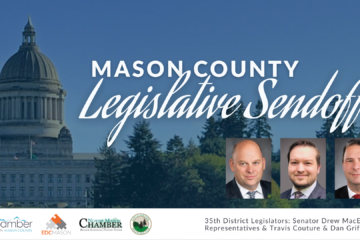Preparing for the New Normal
Emphasize your efforts on three key areas
Mason County is now considered eligible to file for a variance to move toward Stage Two per Governor Inslee’s May 19 press conference. Most states have begun reopening their economies, at least in part. That is the good news. Reopening means its time to plan for a new mode of operation—the sooner, the better. Despite uncertainty, the next step to moving forward is to reopen responsibly. So, what do you need to do that?
First, admit what you know—and what you don’t—about what is expected. Even companies that avoided losses during this period will need a new game plan. The new normal is upon us; why not make it a new, improved normal? Change happened without notice. The downturn hit home immediately when Stay Home, Stay Healthy shut down life as we knew it. Reopening business is inevitable, even imperative, so how does that happen while still in the throes of the first blow? There is no manual, per se, but there is a statewide phased plan dubbed “Safe Start” orchestrated to ease us back into daily routines.
A path to “open” will mean utilizing a Back-to-Business toolkit and considering things like health/safety of returning employees and visitors, logistics, signage, adapting physical workspaces, rerouting public areas, acquiring PPE, and even figuring out how to allow face-to-face exchanges in the break room. All this plus the typical day-to-day tasks. Try to keep it simple by emphasizing your efforts on three key areas.
Financial health and resources: Most business leaders have been scouring for funding in the form of grants and loans from the SBA offered under the CARES Act or from the official COVID-19 Resources for Washington State list. Meanwhile, tough decisions are being made about who/what truly is, or is not, essential. Letting people go, putting your aspirations on hold, and suffering through this is a strain. For now, it’s essential to conserve cash, cut expenses, defer payments, devise a new cost structure, and renegotiate with suppliers. Explore best and worst-case budget scenarios for the coming year. Run numbers for both the short and long term. Be informed about employer credits and relief from the IRS and consult with your CPA. Attend webinars on topics you need to better understand, such as the free upcoming virtual class on Health Reimbursement Arrangements option for individual coverage. Focus on fundamentals and let things go that are sucking up your resources.
Staffing and health/safety: Before a business can reopen, it must embrace the restrictions imposed by COVID-19 health and safety guidelines that arguably carry a legal obligation. The amount of incoming information can be painful to digest, but you are ultimately responsible for being up to code (so to speak). Getting it right will prove useful, not only to survive this crisis, but the next one too. Universally, businesses are expected to set clear limitations such as requiring workers to wear masks and enforcing social distancing. The state’s administration has issued written COVID-19 guidelines, including some industry-specific checklists. Keep in mind these “rules” are not standardized across the country and can even vary by local municipality. A state directive for General Coronavirus Prevention Under Stay Home, Stay Healthy Order is published and covers workplace implementation and enforcement policy.
This is also a good time to retrain and cross train employees for most positions as you revamp operating procedures. Know your options and eligibility regarding unemployment for workers (or yourself). Think about how your employee handbook is written and what it needs to look like. Not every employee will want to come back. Some may still feel unsafe and others may still want to work from home even if your office took necessary precautions. What will you say? Become familiar with your obligations under the Families First Coronavirus Response Act in this overview by the U.S. Chamber of Commerce. Seek out virtual events that have information and subject matter experts on topics that you are dealing with. For example, Association of Washington Business is hosting an HR & Employment Law Webinar series each week from May 20 – July 1 that is open to all employers.
Marketing: Is your business model evolving? What worked in the past may not produce the same results and it may not even be possible. This week is already different from last week, so explore any and all ideas for reconnecting with customers. Evolve technology platforms to engage differently. Become a source of information, perhaps even find a way to monetize online. Remind your customers you exist—and why. After all, they have been in their own survival mode. Get your message out: be seen and heard locally. Reinforce your perceived value and demonstrate you are flexible and able to solve problems virtually. Let them know you are prepared to monitor health and safety aspects in everything you do. Just show you care because good people want to support each other. Drop the buzzwords and be transparent in your communications. Is what you deliver different than before? Make sure that employees grasp why you are in business. Develop an elevator pitch and have everyone commit it to memory so customers receive a consistent message. Brush up on how to create a communications plan for reopening.
Overall, a common-sense approach is all that is needed to weigh compliance with what others believe you should do during reopening phases. Commercials are even airing in an attempt to alleviate customer concerns by promising new, improved customer interactions. Trust your leadership and look forward to emerging stronger and more efficient. There are lots of possibilities for the future. Identify your opportunities and ultimately there will be recovery in the months ahead. Steer away from anxiety that can paralyze you. Instead, look at it from a perspective of getting the chance to do what you could have been doing all along.
